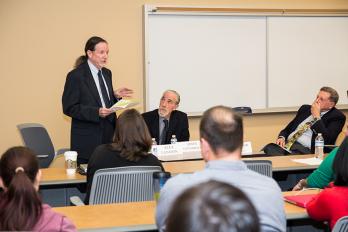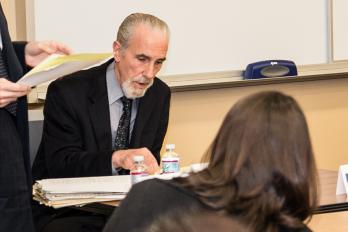National Lawyers Guild Presents Death Penalty Panel at TJSL
March 8, 2013
Is the death penalty a deterrent to crime? Is it worth the huge amount of money that states have to spend on executing death row inmates?
These are two important questions, that have been debated for decades, were discussed at an event held at TJSL on March 7, presented by the National Lawyers Guild and TJSL’s NLG student chapter. The panel was held in honor of the Day Against the Death Penalty.
Three prominent San Diego attorneys who have done extensive work on death penalty cases made up the panel : Criminal Defense Attorney and USD School of Law Adjunct Professor Alex Landon; Criminal Defense Attorney and USD School of Law Adjunct Professor John Cotsirilos and TJSL Adjunct Professor Paul Spiegelman, who is also a defense attorney.
Professor Cotsirilos spoke of the many death penalty cases where the defendants were innocent – and yet still suffered the ultimate penalty.
“People were sent to death across the U.S. where DNA later showed they could not have committed the crime,” Cotsirilos said. “Race is still a big predictor in administering the death penalty,” he added. “People are four times more likely to receive a death sentence if the victim is white.”
In California, the “futility and cost of the death penalty led to the creation of Proposition 34,” Cotsirilos pointed out. That November 2012 ballot measure failed by a margin of 52-48%.
“Since the death penalty was reinstated in California in 1978, the state has spent $4 billion executing prisoners,” said Professor Landon. “That’s $308 million per execution. And more inmates on death row die from natural causes or suicide than by execution.”
Landon doesn’t believe the death penalty is a deterrent to would-be murderers.
“Most people admit now that the death penalty is not a deterrent,” Landon said. “Jurisdictions with the death penalty have higher homicide rates than places without the death penalty.”
Cotsirilos agrees, and said “nothing shows empirically that the death penalty deters future murders. States with the death penalty continue to have higher murder rates.”
“The system in California is totally broken,” said Professor Spiegelman. “And the great fraud of the death penalty is the effect on the family. If someone is sentenced to life in prison without parole, justice is served and they can get on with their lives. But with the death penalty, people often have to spend the greater portion of their lives waiting for justice,” he added, referring to a case where the mother of a six-year old boy was murdered and the boy is now 24-years-old, while the murderer sits on death row.
Former California State Senator John Briggs, who created the Briggs Death Penalty Initiative in the 1970s, is now campaigning for its repeal and replacement with life without parole, according to Professor Spiegelman. Quoting Briggs, he said: “It just hasn’t worked.”




